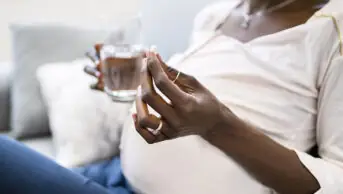
Roger Askew / Alamy Stock Photo
Only a quarter of patients on valproate, who do not have appropriate contraception, are being referred by their pharmacist to their GP or a specialist about the issue, an audit carried out by NHS England has found.
A report on the 2019/2020 Pharmacy Quality Scheme Valproate Audit — which was carried out in community pharmacies across England — published on 11 August 2022, has indicated that the Medicines and Healthcare products Regulatory Agency’s (MHRA’s) safety requirements for use of valproate in women and girls of childbearing age, and trans men who are biologically able to be pregnant, are “still not being fully met”.
Since 2018, the MHRA has advised that valproate, a treatment for epilepsy and bipolar disorder, must not be used in anyone of childbearing potential, unless a Pregnancy Prevention Plan (PPP) is in place.
As part of a PPP, pharmacists are required to remind patients of the risks of taking sodium valproate in pregnancy and the need for highly effective contraception; ensure patients have been given the patient guide; and remind patients of the need for an annual specialist review.
According to the MHRA’s 2018 drug safety update on valproate, if a patient of childbearing potential “reports that she is not taking effective contraception, pharmacists should advise her to contact her GP for an urgent follow-up”.
However, the audit, which was conducted by 10,293 community pharmacies in England, including responses from 12,068 patients and patient representatives, found that pharmacists were not referring or signposting “a sizeable minority”, who appeared to be without appropriate contraception, back to the prescriber.
Overall, 63.8% (7,693) of patients reported having highly effective contraception but 36.2% (4,374) did not. Of the latter, only 26.5% (1,159) were referred to the GP by the pharmacist about this issue.
The report said that community pharmacists should refer “all people aged 12–55 who are biologically able to be pregnant and have not had their valproate medication reviewed within the last 12 months to their GP or specialist, as well as to local contraception services as appropriate”.
For patients not referred to their GP or specialist, the report said that the pharmacist should be able to confirm that the patient is fully informed, understands the risks of not using highly effective contraception and knows who to contact if their circumstances change.
The audit also found that although 94.4% of patients were provided with advice and information about valproate, more than 5% (675 people) were not. In addition, 10.6% of respondents did not have the patient guide and 11.1% had not been given the patient card.
The report said it was “not clear” why this was the case but that potential reasons could include the individual not wanting to have a discussion with their pharmacist or medicines being collected on behalf of a patient.
It added that the figures warranted “further investigation”.
Daniel Jennings, senior policy and campaigns officer at the charity Epilepsy Action, said it was “very worrying” that despite the efforts of the MHRA, there were still women and girls not receiving the information about the risks of taking sodium valproate during pregnancy.
“While great progress has been made in communicating these risks, there is still more that needs to be done to identify and reach those people who have not been receiving a patient card with their medication.
“While the figures may seem small, it is vital that all women and girls with a prescription of valproate are informed of the risks of taking valproate during pregnancy, so that they can make an informed choice about their treatment.”
Jennings said that one of the recommendations of the Independent Medicines and Medical Devices Safety Review report ‘First Do No Harm’, published in July 2020, was an online system for the PPP, including confirmation that the risk acknowledgement form had been signed within the previous year.
“This system would enable pharmacists to rapidly identify patients who may require a review,” he continued.
“It is therefore vital that this, and indeed the other recommendations of the report, are implemented in full and Epilepsy Action will continue to call on the government to ensure this happens.”
A valproate audit published by the Company Chemists’ Association in November 2019 found that only 40.1% of community pharmacy teams were issuing warning cards when dispensing valproate. This audit was voluntary and was completed before some safety materials were available.
Click here to read the CPD article ‘Valproate use in women: minimising the risks’


